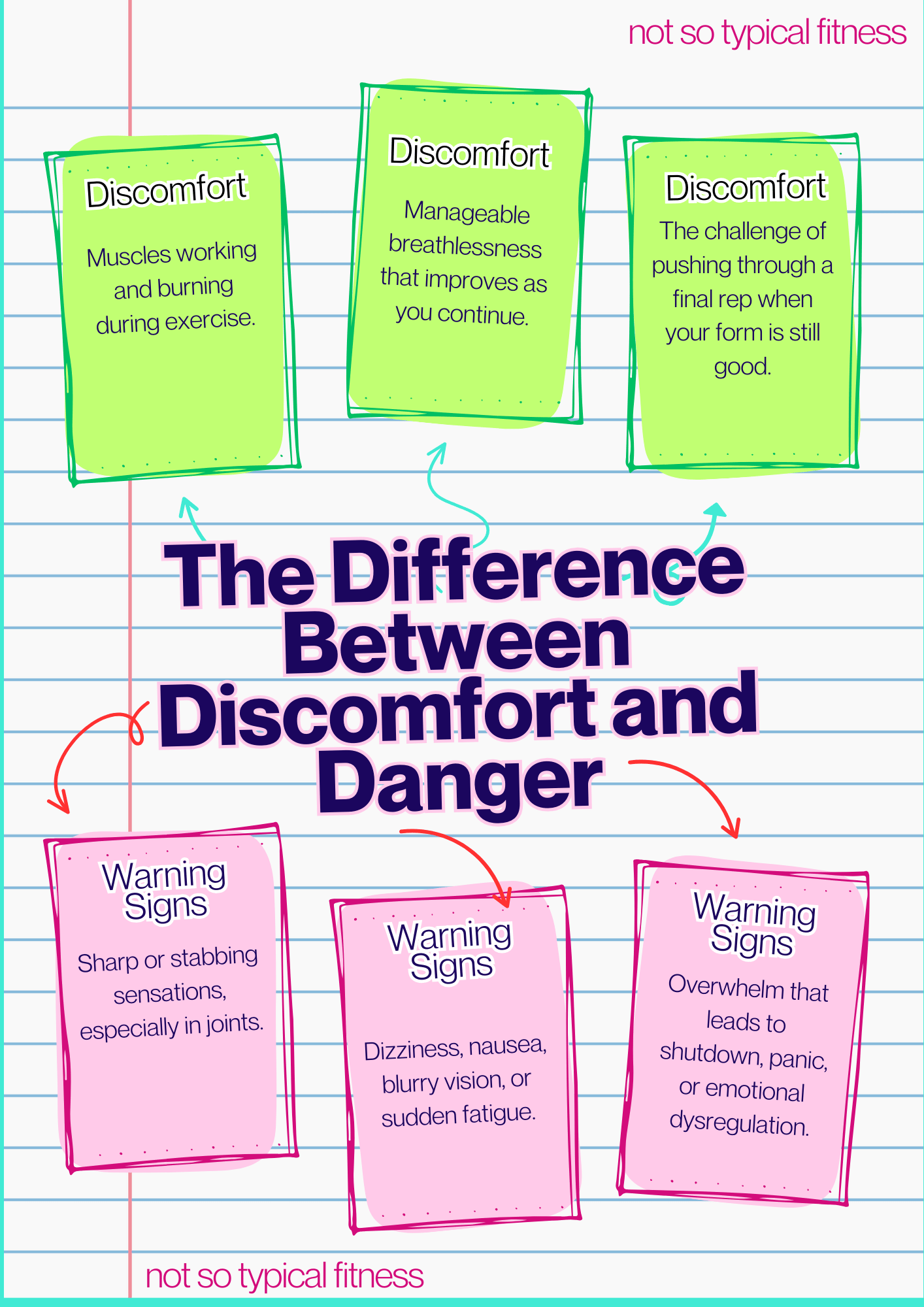Ditching the ‘No Pain, No Gain’ Mentality
Fitness Doesn't Have to Hurt!
I used to chase the burn in every workout until it landed me injured and burnt out for three months. If you're neurodivergent or dealing with chronic conditions, that 'no pain, no gain' mentality isn't just wrong, it's harmful.
Here's the truth the fitness industry doesn't want you to know; pain isn't a requirement for progress. This is especially crucial for those of us navigating ADHD, autism, chronic conditions, or just life happening behind the scenes.
If you've been caught in cycles of guilt, injury, or burnout from chasing pain-based workouts, this post will show you there's a better way.
The Critical Difference Between Discomfort and Danger
Understanding your body's signals is one of the most important fitness skills, yet it's rarely discussed, especially in neurodivergent circles. Learning to distinguish between productive discomfort and harmful pain can completely transform your relationship with movement.
What does discomfort feel like?
Productive discomfort might feel like:
Muscles working and burning during exercise
Manageable breathlessness that improves as you continue
The challenge of pushing through a final rep when your form is still good
What does danger feel like?
Dangerous pain feels like:
Sharp or stabbing sensations, especially in joints
Dizziness, nausea, blurry vision, or sudden fatigue
Overwhelm that leads to shutdown, panic, or emotional dysregulation.
If something feels off, you're allowed to stop. You're allowed to modify. You're allowed to listen to your body, even when everyone else is pushing for "one more round."
The 'no pain, no gain' mentality is especially harmful if you experience Rejection Sensitive Dysphoria. When criticism—even self-directed criticism—triggers intense shame or emotional shutdown, pushing yourself harder doesn't build resilience. It builds avoidance. Compassion isn't weakness; it's how you actually sustain progress.
For those of us who've learned to mask or push through everything, recognising when we've gone too far can be particularly challenging. This skill takes practice, and that's completely normal.
Why "Easy" Workouts Are Still Real Workouts
There's a toxic belief that workouts must be intense to be effective; that if you're not sore the next day, it didn't "count." This mindset has trapped countless people in cycles of overexertion and burnout.
I believed this too. When I was burnt out, anxious, or navigating sensory overwhelm, pushing through made everything worse. It didn't build strength—it built resentment toward movement itself.
Everything changed when I started asking: "What kind of movement will help me show up again tomorrow?"
Surprisingly (or not…), that answer was never burpees or high-intensity intervals. Instead, it was:
15-minute walks while listening to a podcast
Three sets of wall push-ups during Netflix commercial breaks
10 minutes of stretching on my bedroom floor with lo-fi music
Dancing in my kitchen to Taylor Swift while making dinner
Five bodyweight squats every time I went to the bathroom
Sustainable progress comes from consistency, not punishment. And you're far more likely to be consistent with activities you don't dread.
This 'fitness as punishment' mindset shows up everywhere—even on holiday. Ever felt guilty about not using the hotel gym? That's diet culture telling you that rest needs to be 'earned.' It doesn't.
My Turning Point: Choosing Kindness Over Suffering
For years, I believed pain meant progress. The harder I pushed, the more "serious" I was about getting stronger, leaner, better. But this mentality left me injured, exhausted, and increasingly disconnected from my body.
The breaking point came after a particularly brutal workout that left me unable to lift my arms above my head for a week. I realised I was treating my body like an enemy to conquer rather than a partner to care for.
My turning point wasn't a dramatic revelation—it was a series of small decisions. Saying "no" to what didn't feel right and "yes" to what helped me reconnect with my body on my own terms. Over time, these choices built real, lasting strength that enhanced my life instead of depleting it.
Here's what I've learned through trial, error, and self-compassion:
You don't have to suffer to earn your results
You don't have to be exhausted to feel accomplished
You don't have to hate every second for it to "count"
Progress isn't always visible or measurable
Considerations for Neurodivergent People
If you're autistic, have ADHD, anxiety, or identify somewhere along the neurodivergent spectrum, traditional fitness advice often misses the mark. Consider these factors:
Sensory challenges like loud music and packed gyms can be overwhelming, making home workouts or quieter spaces more suitable.
Executive function and transitions are difficult, so starting a workout might require more mental energy than the actual exercise.
Emotional regulation can lead to meltdowns, shutdowns, and executive dysfunction affect every aspect of life, including how you approach movement.
Please know this: You're not weak. You're not lazy. You're not broken. You're navigating movement in a world that wasn't designed with your brain in mind. The fact that you're still showing up is incredibly powerful.
Redefining Fitness Success
Movement should be empowering, accessible, and yes, dare I say it, even joyful.
If your current approach to fitness isn't serving these goals, you have the right to change it. Progress isn't always measured in sweat, soreness, or intensity. Sometimes it's measured in how you feel afterward, how consistently you show up, or simply how much more connected you feel to your body.
True fitness is about finding sustainable ways to care for yourself. It's about building a positive relationship with movement that enhances your life rather than adding stress to it.
Fitness should be about finding strength in who you are.
Moving Forward
If you've been caught in the loop of guilt and burnout from pain-based workout culture, remember that there's another way. Start small, listen to your body, and give yourself permission to redefine what successful movement looks like for you.
Because at the end of the day, fitness doesn't have to hurt. It just has to work for you.




